개요
OneSignal React Native 및 Expo SDK를 iOS 및 Android 앱에 통합하기 위한 단계별 가이드입니다. 이 가이드를 마치면 OneSignal로 푸시 알림 및 In-App Message를 보낼 수 있습니다.요구 사항
- 관리형 Expo 앱입니다. bare React Native 앱의 경우 React Native SDK 설정을 참조하세요.
- Expo 개발 빌드
- Expo SDK 48+ (지침은 버전 54.0.8 사용)
- EAS CLI (EAS Build 문서)
- React Native 0.71+ (지침은 버전 0.81.4 사용)
- 구성된 OneSignal 앱 및 플랫폼
- Xcode 14+가 설치된 macOS (설정 지침은 Xcode 16.2 사용)
- iOS 12+, iPadOS 12+ 장치 또는 iOS 16.2+를 실행하는 Xcode 시뮬레이터
- CocoaPods 1.16.2+
- Google Play Store(서비스)가 설치된 Android 7.0+ 장치 또는 에뮬레이터
OneSignal 앱 및 플랫폼 구성
푸시 알림에 필요한 설정 OneSignal로 푸시 알림 전송을 시작하려면 먼저 지원하는 모든 플랫폼(Apple (APNs), Google (FCM), Huawei (HMS) 및/또는 Amazon (ADM))으로 OneSignal 앱을 구성해야 합니다.OneSignal 앱 구성을 위한 단계별 지침.
OneSignal 앱 구성을 위한 단계별 지침.
앱 만들기 또는 선택
- 기존 앱에 플랫폼을 추가하려면 OneSignal 대시보드에서 설정 > 푸시 및 인앱으로 이동합니다.
- 처음부터 시작하려면 New App/Website를 클릭하고 프롬프트를 따릅니다.
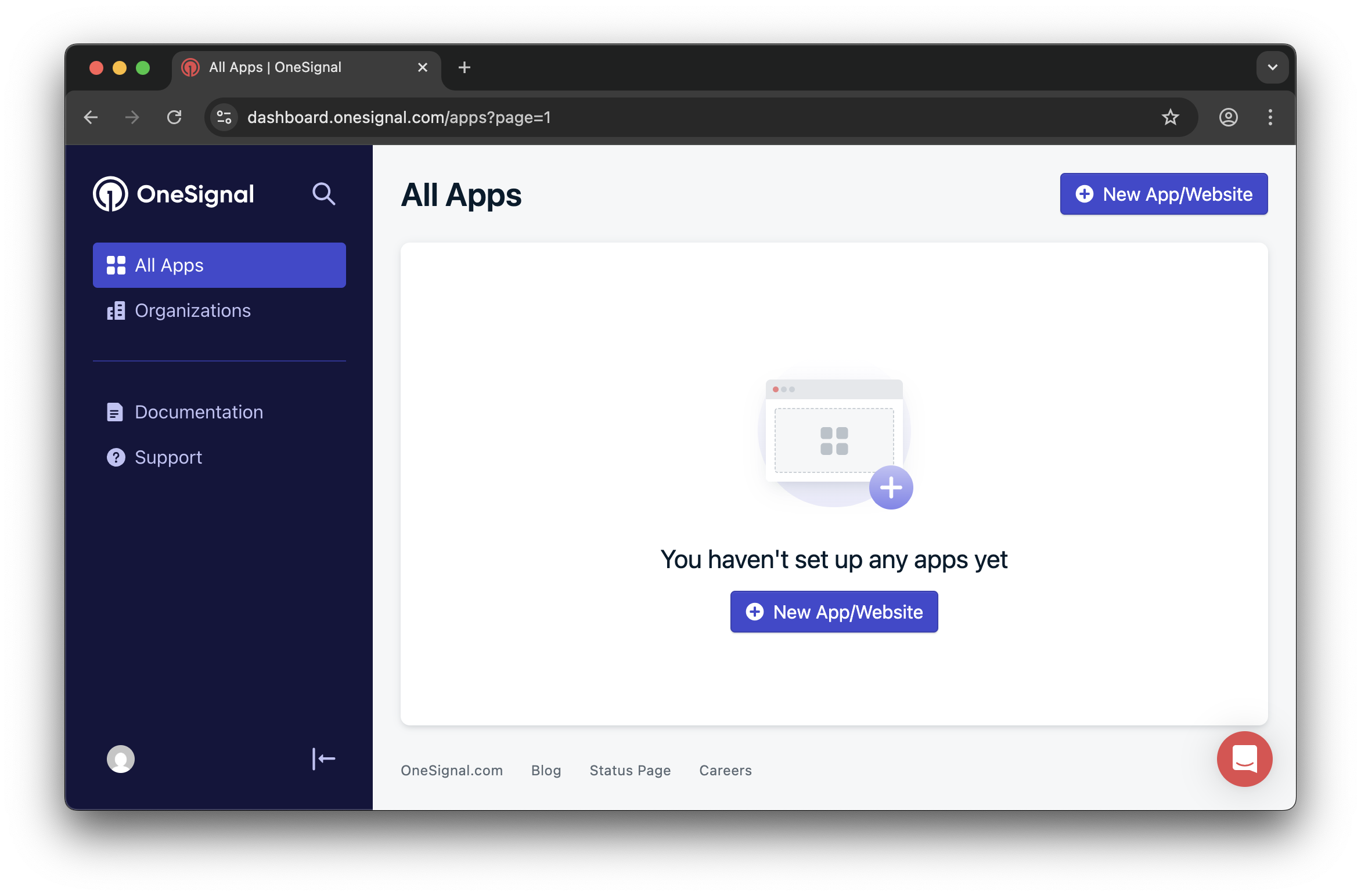
새 앱 만들기를 보여주는 예제.
플랫폼 설정 및 활성화
- 앱 및 조직에 대해 명확하고 인식 가능한 이름을 선택합니다.
- 구성하려는 플랫폼(iOS, Android 등)을 선택합니다.
- Next: Configure Your Platform을 클릭합니다.

첫 번째 OneSignal 앱, 조직 및 채널 설정 예제.
플랫폼 자격 증명 구성
- Android: Firebase 자격 증명 설정
- iOS: p8 토큰(권장) 또는 p12 인증서
- Amazon: API 키 생성
- Huawei: OneSignal 권한 부여
대상 SDK 선택
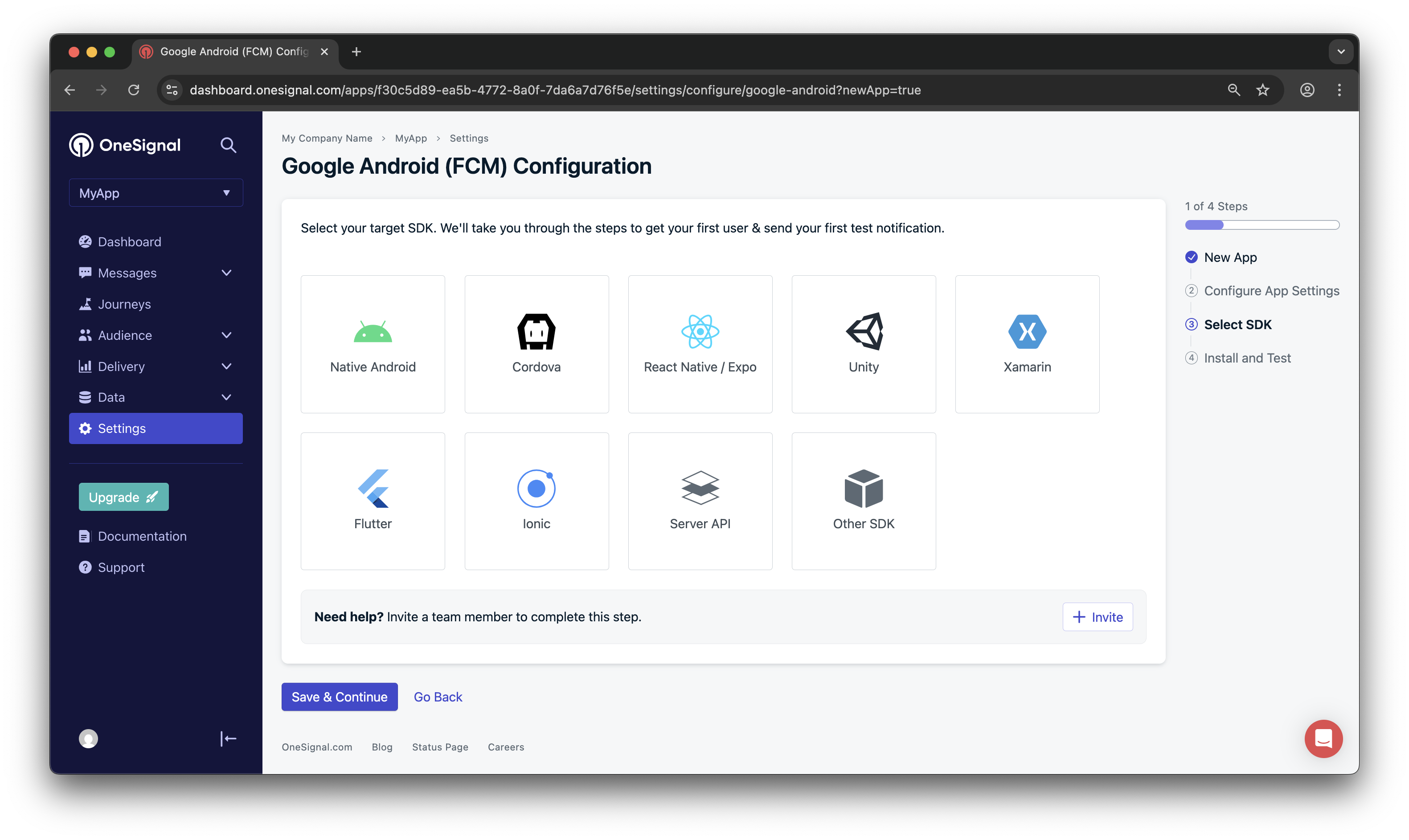
문서로 이동할 사용 중인 SDK 선택.
SDK 설치 및 앱 ID 저장

앱 ID를 저장하고 추가 팀 구성원을 초대합니다.
SDK 설정
1. SDK 추가
Expo CLI를 사용하여 OneSignal Expo 플러그인을 설치합니다.react-native-onesignal 패키지를 추가합니다.
2. 플러그인 구성
app.json(또는 app.config.js)을 엽니다. 다음 설정을 포함해야 합니다.
필수 설정
"bundleIdentifier": OneSignal 앱에서 사용 중인 p8 또는 p12 인증과 일치하는 앱의 번들 식별자입니다."infoPlist":UIBackgroundModes키를["remote-notification"]으로 설정해야 합니다."entitlements"- 테스트의 경우
aps-environment키를"development"로, Testflight 및 App Store 빌드의 경우"production"으로 설정해야 합니다. com.apple.security.application-groups키를["group.${ios.bundleIdentifier}.onesignal"]로 설정해야 합니다.
- 테스트의 경우
"android":package키를 앱의 패키지 이름으로 설정해야 합니다."plugins": 앱의plugins배열입니다. 플러그인[onesignal-expo-plugin]을 플러그인 배열의 맨 위에 추가해야 합니다. 또한 테스트의 경우mode키를"development"로, Testflight 및 App Store 빌드의 경우"production"으로 설정해야 합니다.
추가 플러그인 속성
추가 플러그인 속성
| Prop | 필수 | 설명 |
|---|---|---|
mode | ✅ | APNs 환경 자격을 구성합니다. 테스트에는 "development"를 사용하고 TestFlight 및 App Store 빌드에는 "production"으로 전환합니다. |
devTeam | ❌ | expo credentials:manager를 실행하여 찾을 수 있는 Apple Team ID입니다(예: "91SW8A37CR"). |
iPhoneDeploymentTarget | ❌ | 앱이 지원하는 최소 iOS 버전을 설정합니다. Podfile의 값과 일치해야 합니다(예: "15.0"). |
smallIcons | ❌ | Android 작은 알림 아이콘 경로의 배열입니다(흰색, 투명, 96x96px). 이 이미지는 자동으로 크기 조정됩니다. 예시: ["./assets/ic_stat_onesignal_default.png"] |
largeIcons | ❌ | Android 큰 알림 아이콘 경로의 배열입니다(흰색, 투명, 256x256px). 예시: ["./assets/ic_onesignal_large_icon_default.png"] |
smallIconAccentColor | ❌ | Android 알림 아이콘 강조 색상으로 사용되는 16진수 색상 값입니다. 예시: "#FF0000" |
iosNSEFilePath | ❌ | Objective-C의 사용자 지정 iOS Notification Service Extension 파일 경로입니다. 예시: "./assets/NotificationService.m" |
3. SDK 초기화
Expo 구조(Traditional App entry 또는 Expo Router)에 따라 다음 옵션을 사용하여 OneSignal을 초기화합니다.- Traditional App Entry
- Expo Router
App.tsx 또는 App.js 파일에서 제공된 메서드를 사용하여 OneSignal을 초기화합니다.OneSignal 대시보드 **Settings > Keys & IDs**에서 찾을 수 있는 OneSignal 앱 ID로 YOUR_APP_ID를 교체하세요.Android 설정
Firebase 자격 증명을 사용하여 Android 플랫폼에 대해 OneSignal 앱이 구성되었는지 확인하세요. 앱 브랜딩과 일치하도록 알림 아이콘을 설정합니다. 이 단계를 건너뛰면 푸시 알림에 기본 벨 아이콘이 표시됩니다. Android용 빌드 이 시점에서 문제 없이 실제 Android 장치 또는 에뮬레이터에서 앱을 빌드하고 실행할 수 있어야 합니다.- 해당하는 경우 iOS 설정을 계속합니다.
- 또는 OneSignal SDK 통합 테스트로 건너뜁니다.
iOS 설정
p8 토큰(권장) 또는 p12 인증서를 사용하여 OneSignal 앱이 iOS 플랫폼에 대해 구성되어 있는지 확인하세요.iOS용 빌드
이제 실제 iOS 장치 또는 iOS 시뮬레이터(16.2+)에서 앱을 빌드하고 실행할 수 있습니다.일반적인 iOS 빌드 오류
Cycle Inside... building could produce unreliable results.
Cycle Inside... building could produce unreliable results.
- Xcode에서
.xcworkspace폴더를 열고 your app target > Build Phases로 이동합니다. - “Embed Foundation Extensions” 또는 **“Embed App Extensions”**라는 단계가 있어야 합니다.
- 이 빌드 단계를 드래그하여 “Run Script” 위로 이동합니다.
- 앱을 빌드하고 실행합니다. 오류가 해결되어야 합니다.

Xcode의 Build Phases 올바른 순서입니다.

Copy only when installing 선택을 해제합니다.
PBXGroup Error
PBXGroup Error
PBXGroup attempted to initialize an object with unknown ISA PBXFileSystemSynchronizedRootGroup from attributes: {"isa"=>"...", "exceptions"=>["//", "..."], "explicitFileTypes"=>{}, "explicitFolders"=>[], "path"=>"OneSignalNotificationServiceExtension", "sourceTree"=>"<group>"}- 오류에서 “path” 아래에 나열된 폴더를 찾습니다.
- Xcode 프로젝트 사이드바에서 폴더를 마우스 오른쪽 버튼으로 클릭합니다.
- Convert to Group을 선택합니다.

PBXGroup의 경로 오류입니다.
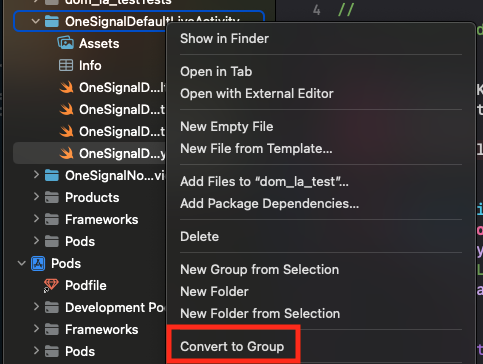
폴더를 그룹으로 변환합니다.
Testing the OneSignal SDK integration
This guide helps you verify that your OneSignal SDK integration is working correctly by testing push notifications, subscription registration, and in-app messaging.Check mobile subscriptions
Launch your app on a test device.
requestPermission method during initialization.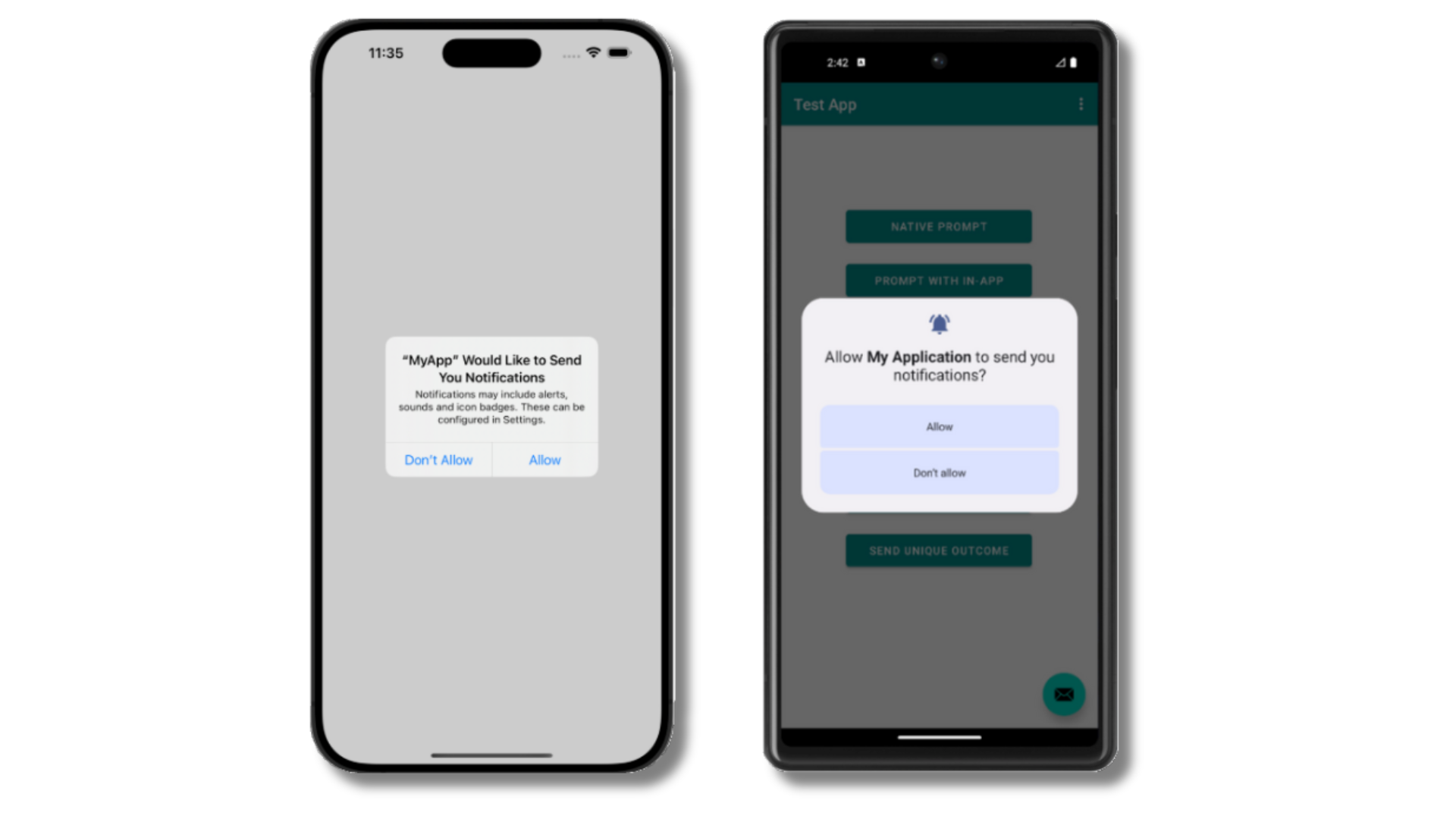
iOS and Android push permission prompts
Check your OneSignal dashboard
- Go to Audience > Subscriptions.
- You should see a new entry with the status “Never Subscribed”.
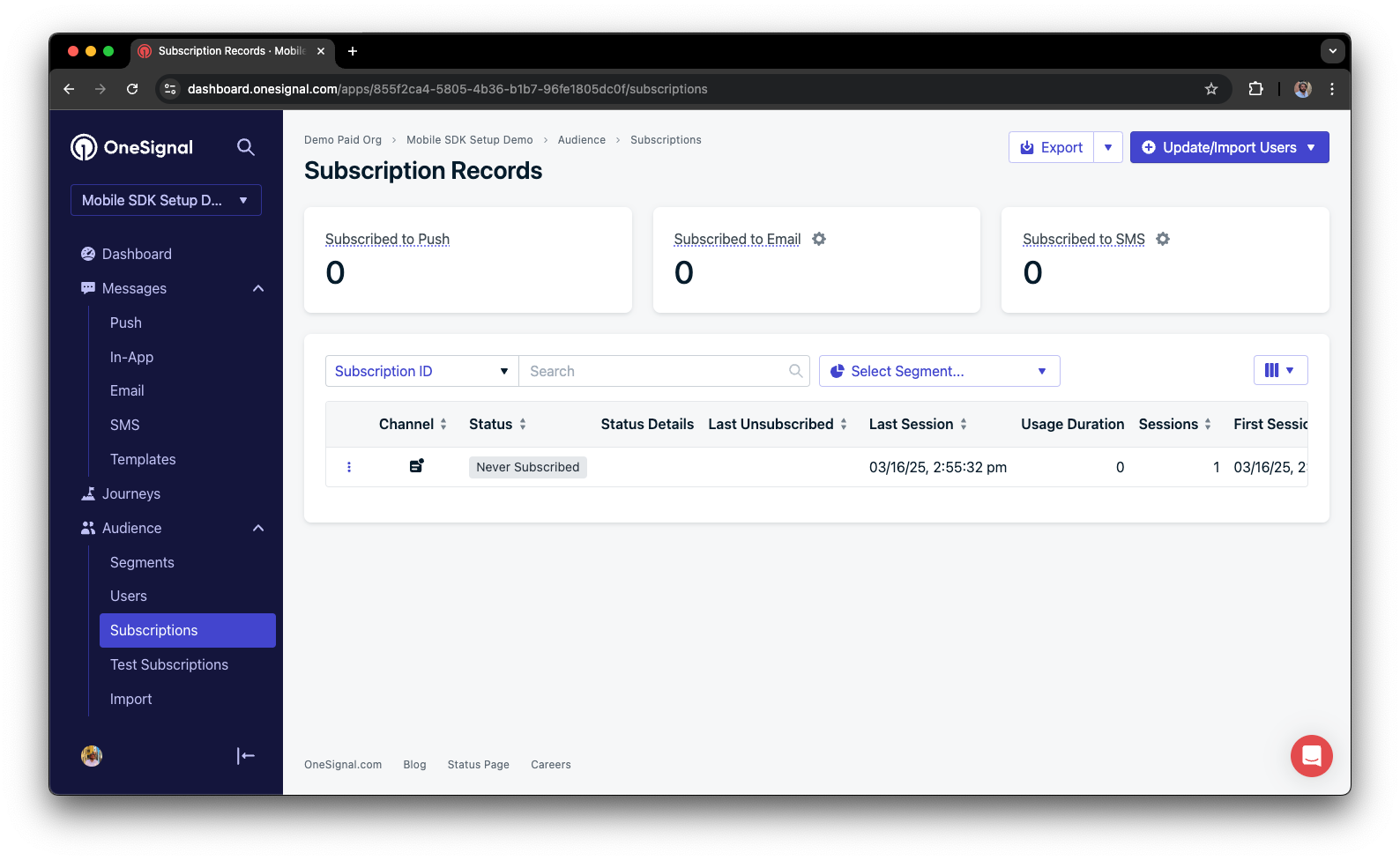
Dashboard showing subscription with 'Never Subscribed' status
Return to the app and tap Allow on the prompt.
Refresh the OneSignal dashboard Subscription's page.
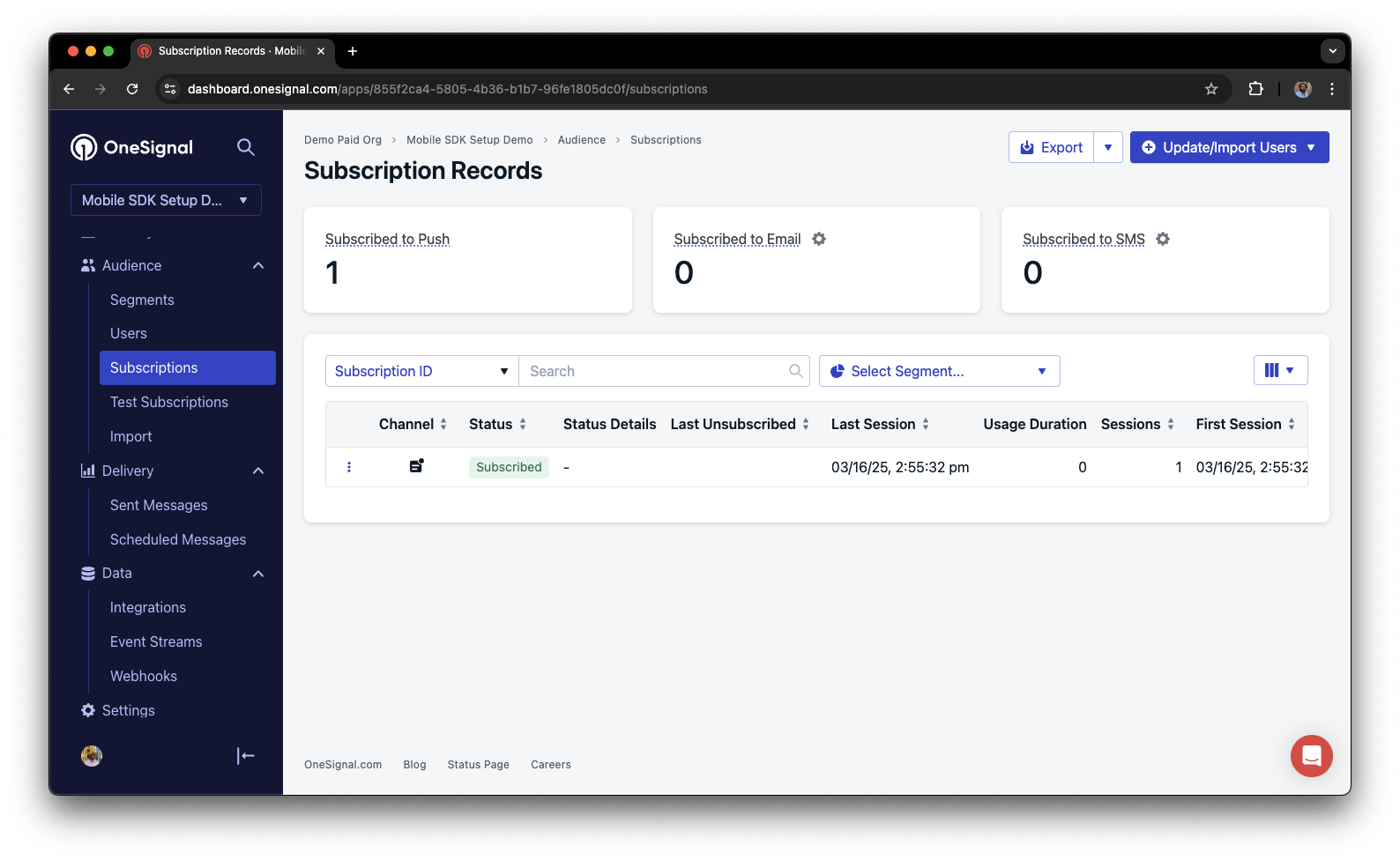
Dashboard showing subscription with 'Subscribed' status
Set up test subscriptions
Test subscriptions are helpful for testing a push notification before sending a message.Add to Test Subscriptions.
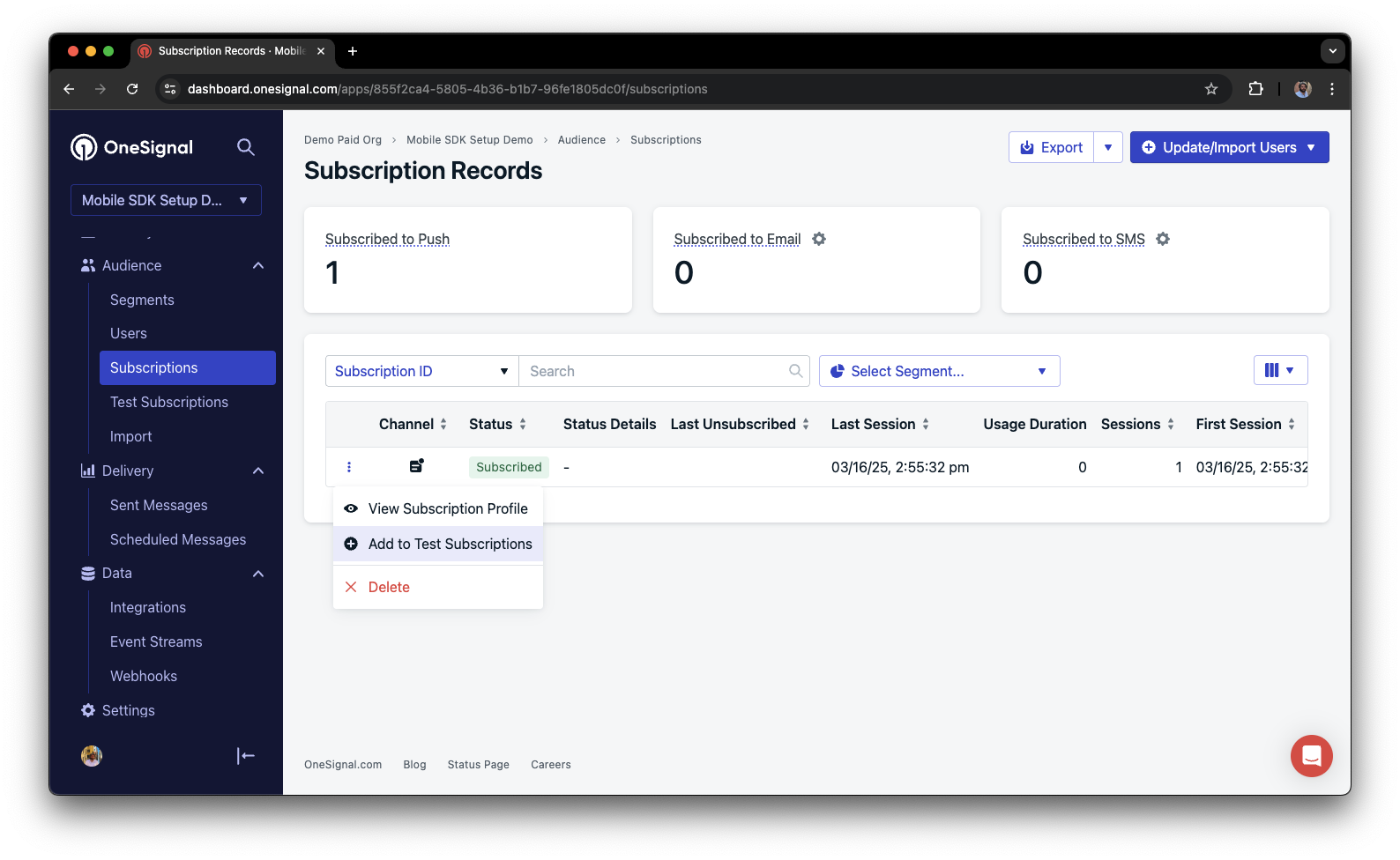
Adding a device to Test Subscriptions
Name your subscription.
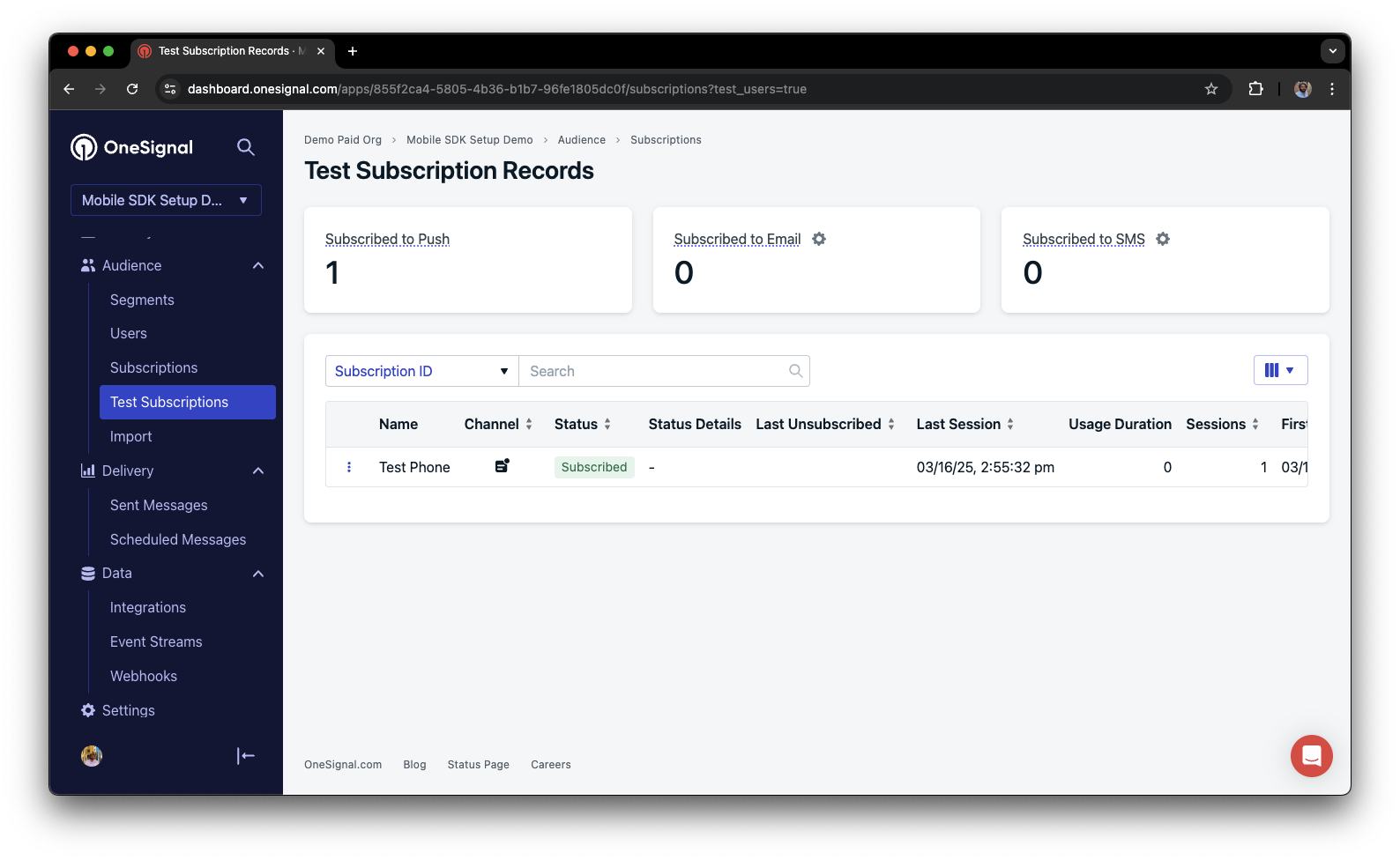
Dashboard showing the 'Name your subscription' field
Create a test users segment.
Name the segment.
Test Users (the name is important because it will be used later).Add the Test Users filter and click Create Segment.
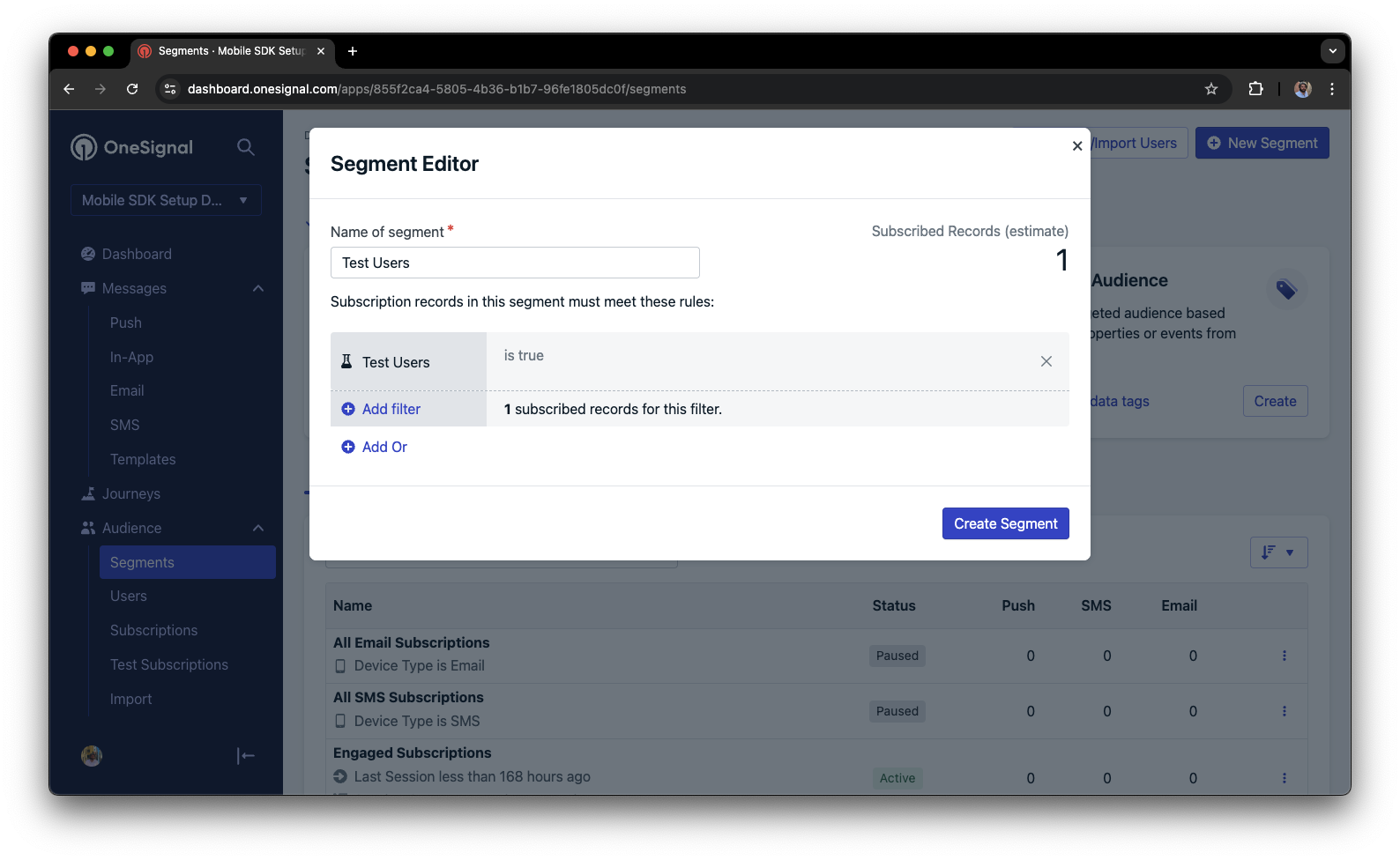
Creating a 'Test Users' segment with the Test Users filter
Send test push via API
Get your App API Key and App ID.
Update the provided code.
YOUR_APP_API_KEY and YOUR_APP_ID in the code below with your actual keys. This code uses the Test Users segment we created earlier.Run the code.
Check images and confirmed delivery.
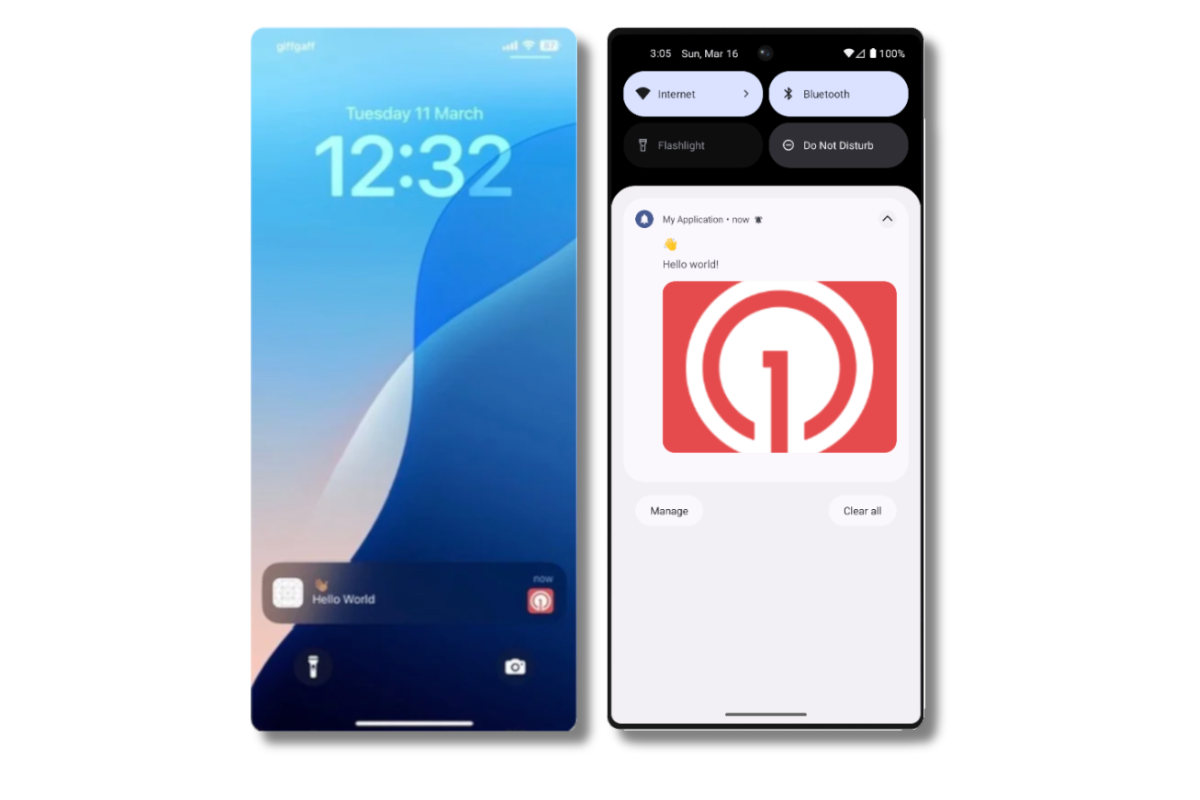
Push notification with image on iOS and Android
Check for confirmed delivery.
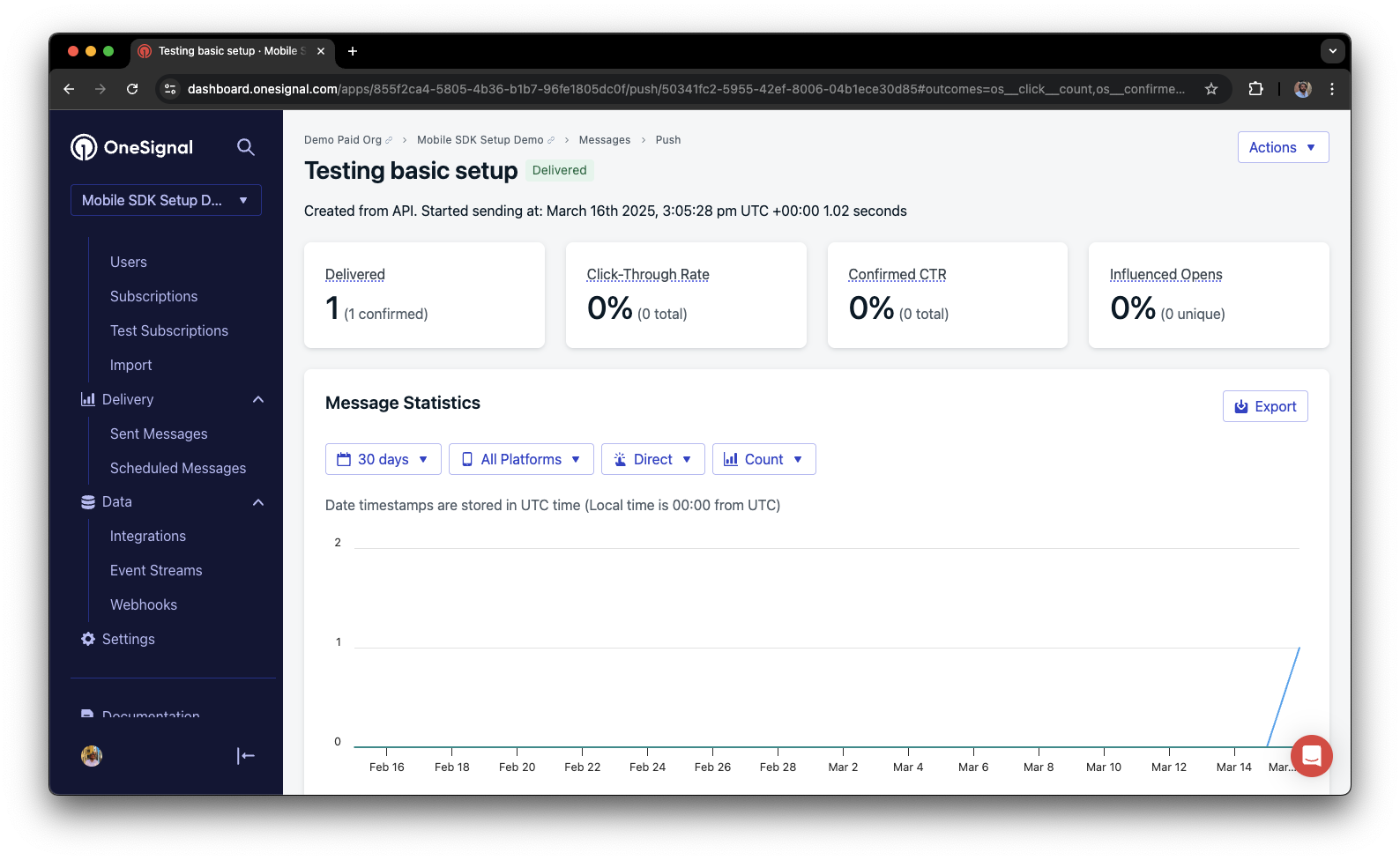
Delivery stats showing confirmed delivery
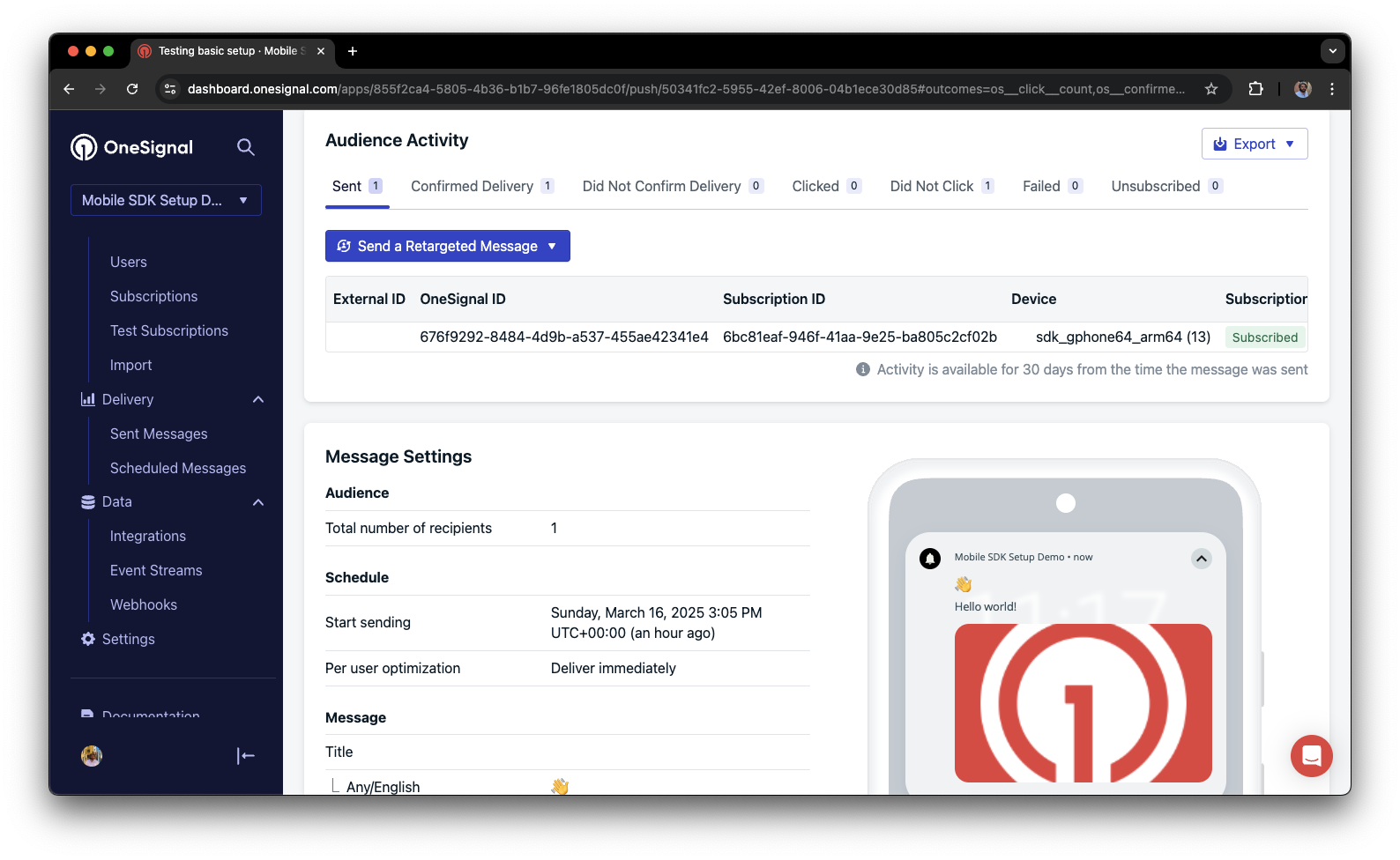
Confirmed delivery at the device level in Audience Activity
Send an in-app message
In-app messages let you communicate with users while they are using your app.Close or background your app on the device.
Create an in-app message.
- In your OneSignal dashboard, navigate to Messages > In-App > New In-App.
- Find and select the Welcome message.
- Set your Audience as the Test Users segment we used previously.
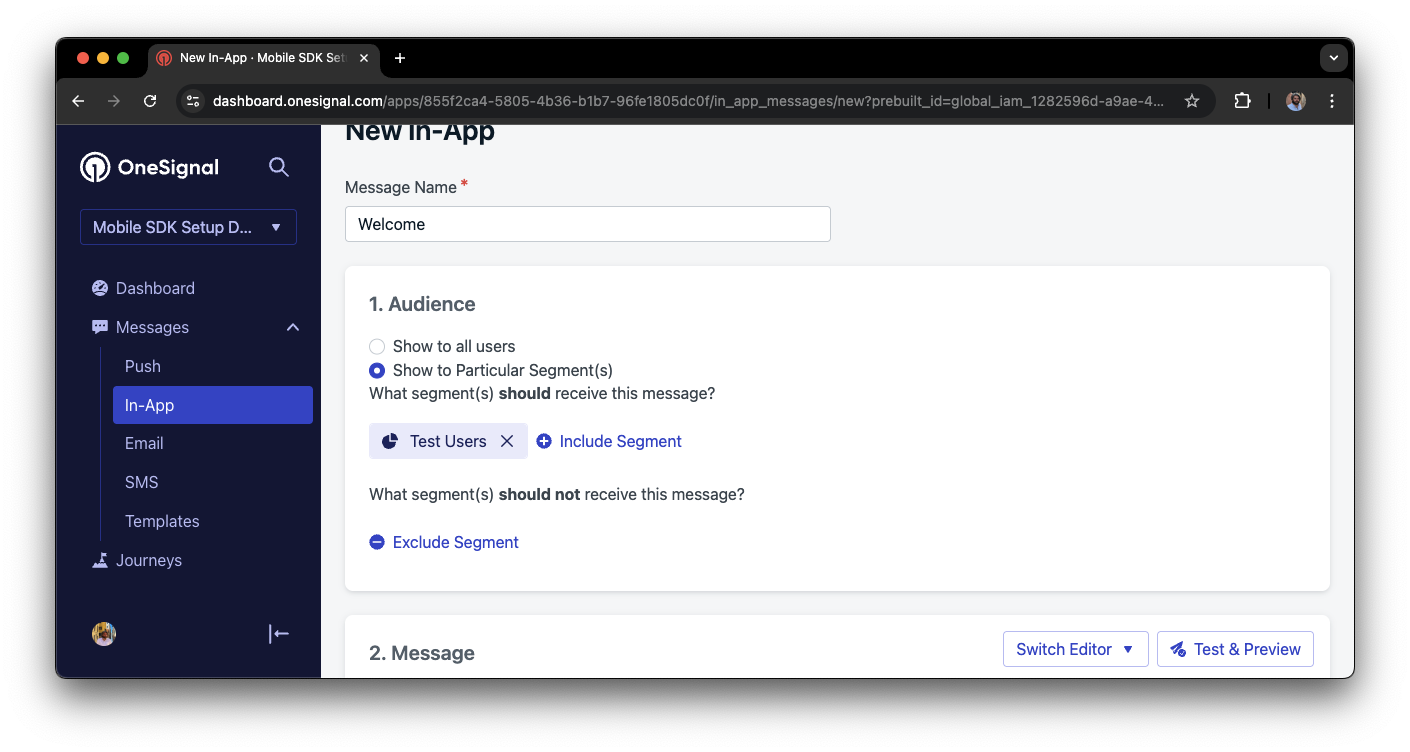
Targeting the 'Test Users' segment with an in-app message
Customize the message content if desired.
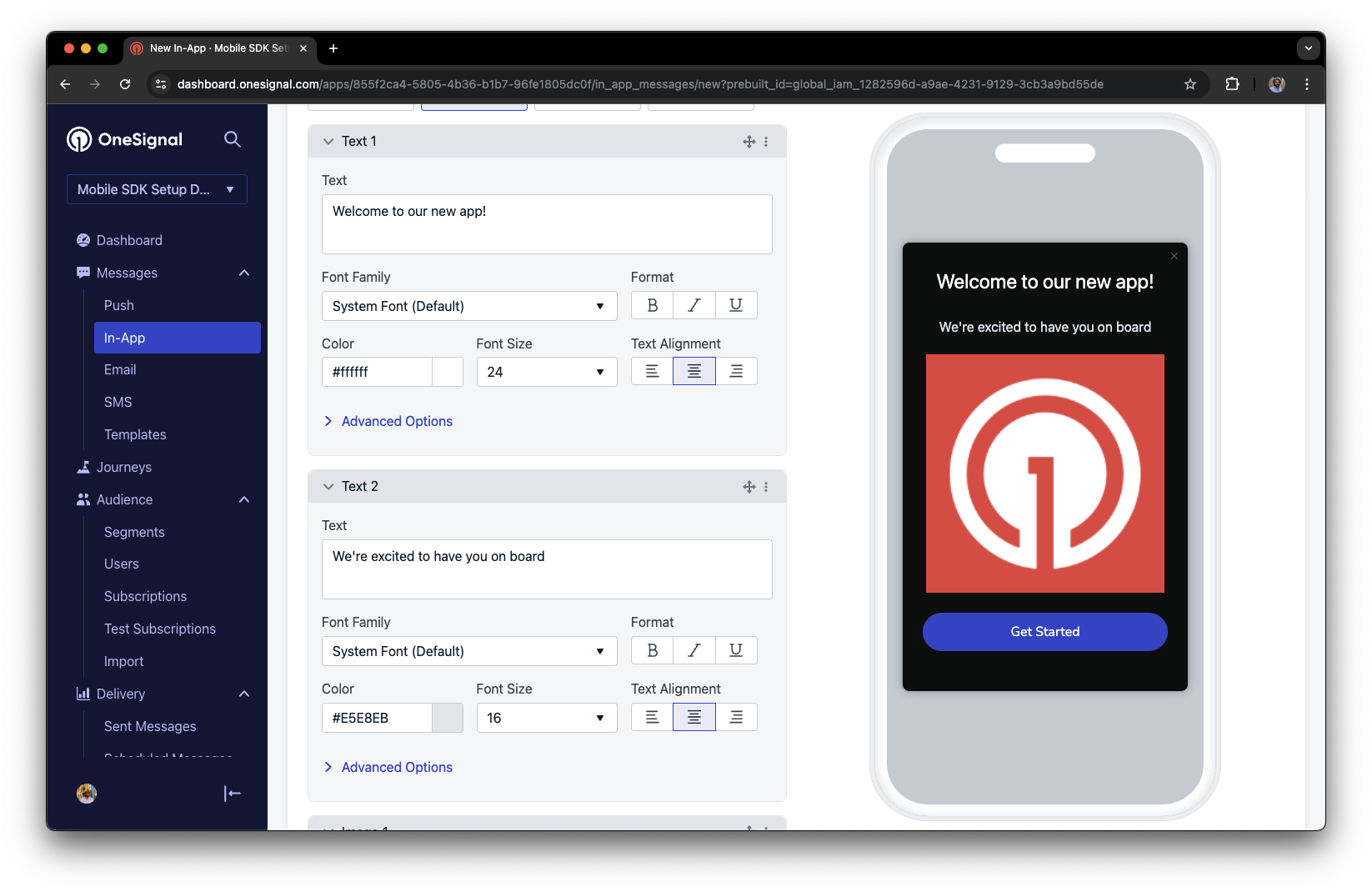
Example customization of in-app Welcome message
Set Trigger to 'On app open'.
Schedule frequency.
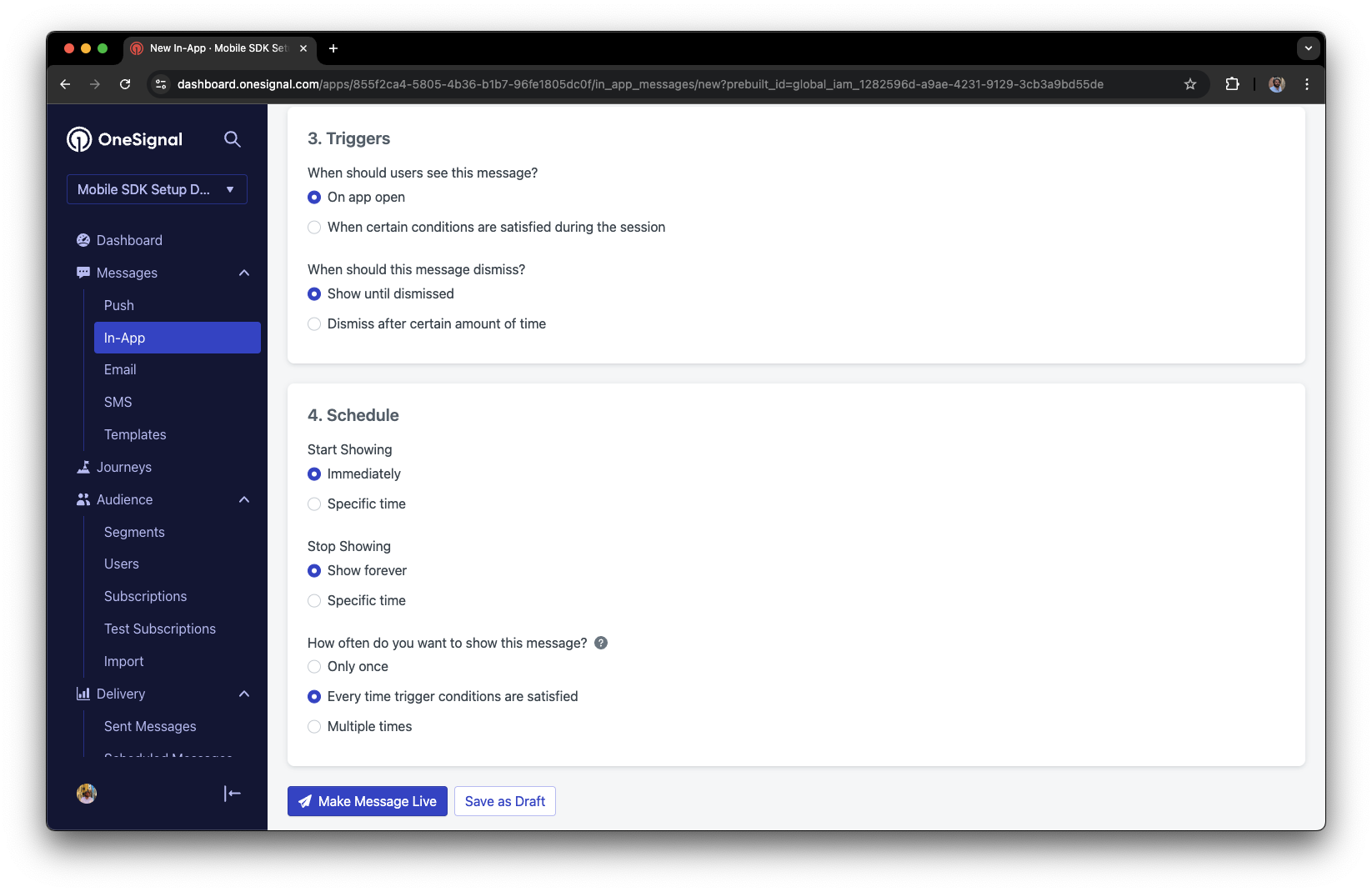
In-app message scheduling options
Make message live.
Open the app and see the message.
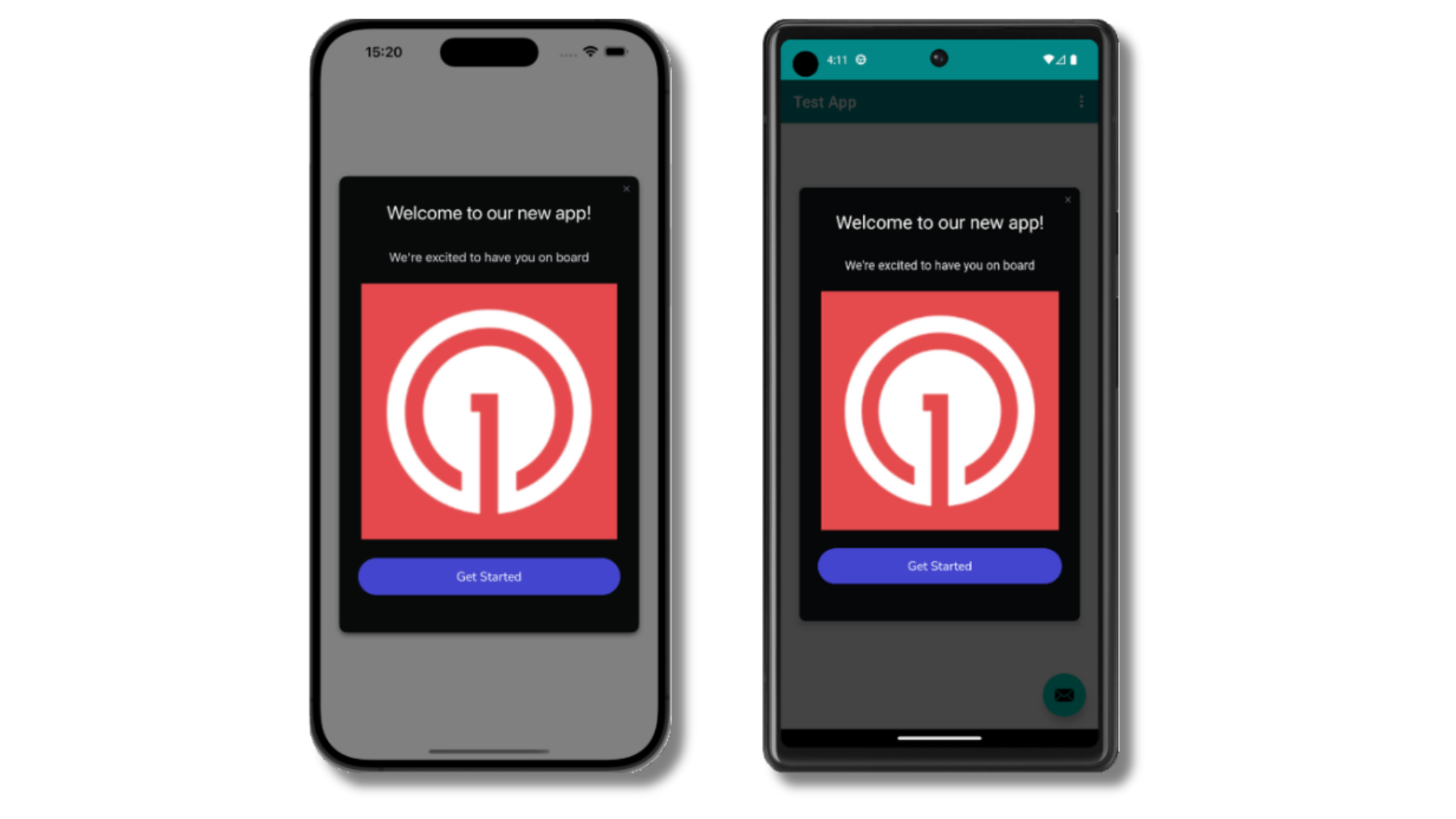
Welcome in-app message shown on devices
- Gathering Subscriptions, setting Test subscriptions, and creating Segments.
- Sending Push with images and Confirmed Delivery using Segments and our Create message API.
- Sending In-app messages.
User identification
Previously, we demonstrated how to create mobile Subscriptions. Now we’ll expand to identifying Users across all their subscriptions (including push, email, and SMS) using the OneSignal SDK. We’ll cover External IDs, tags, multi-channel subscriptions, privacy, and event tracking to help you unify and engage users across platforms.Assign External ID
Use an External ID to identify users consistently across devices, email addresses, and phone numbers using your backend’s user identifier. This ensures your messaging stays unified across channels and 3rd party systems (especially important for Integrations). Set the External ID with our SDK’slogin method each time they are identified by your app.
Add data tags
Tags are key-value pairs of string data you can use to store user properties (likeusername, role, or preferences) and events (like purchase_date, game_level, or user interactions). Tags power advanced Message Personalization and Segmentation allowing for more advanced use cases.
Set tags with our SDK addTag and addTags methods as events occur in your app.
In this example, the user reached level 6 identifiable by the tag called current_level set to a value of 6.
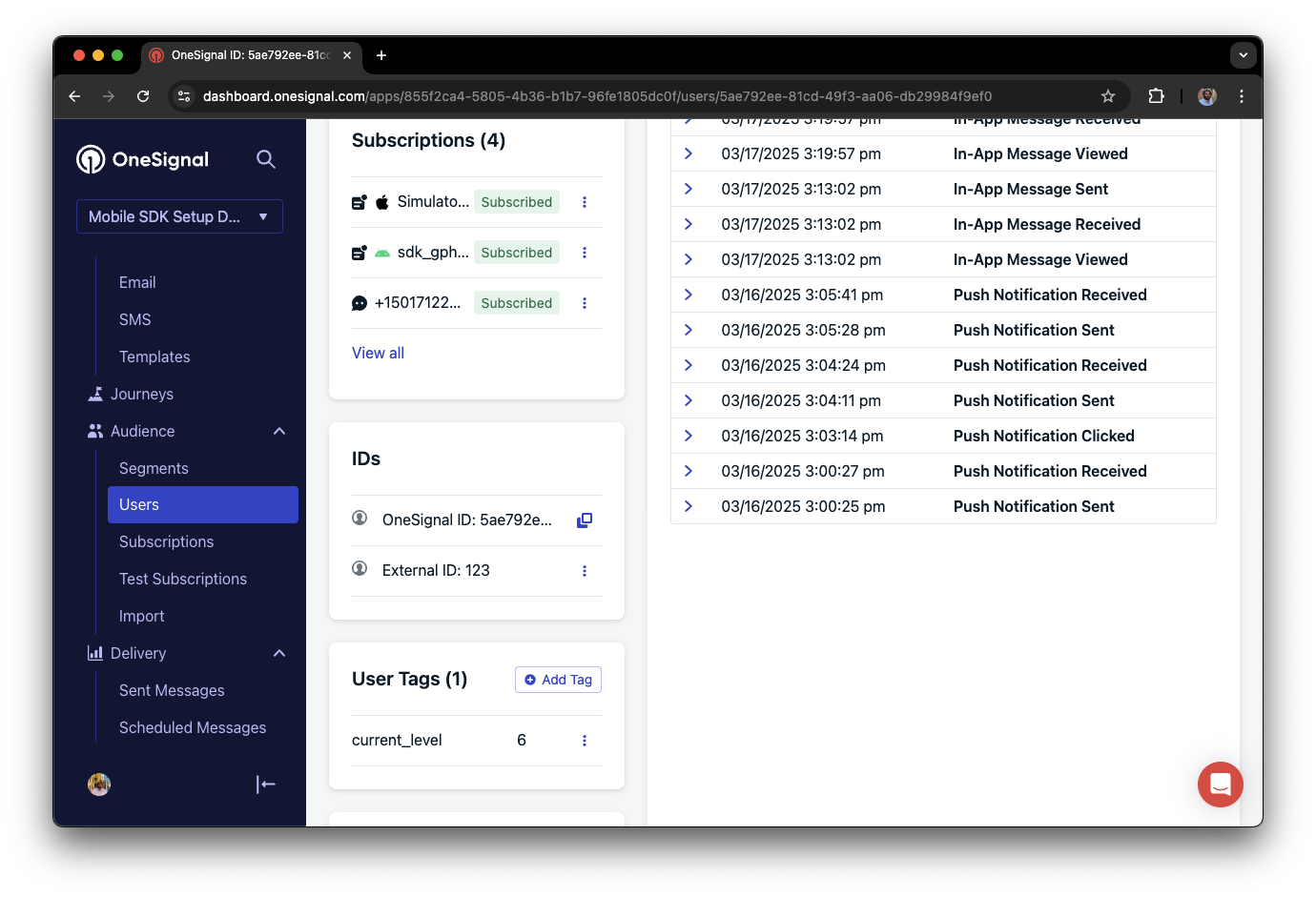
A user profile in OneSignal with a tag called "current_level" set to "6"

Segment editor showing a segment targeting users with a current_level value of greater than 4 and less than 10

Screenshot showing a push notification targeting the Level 5-10 segment with a personalized message
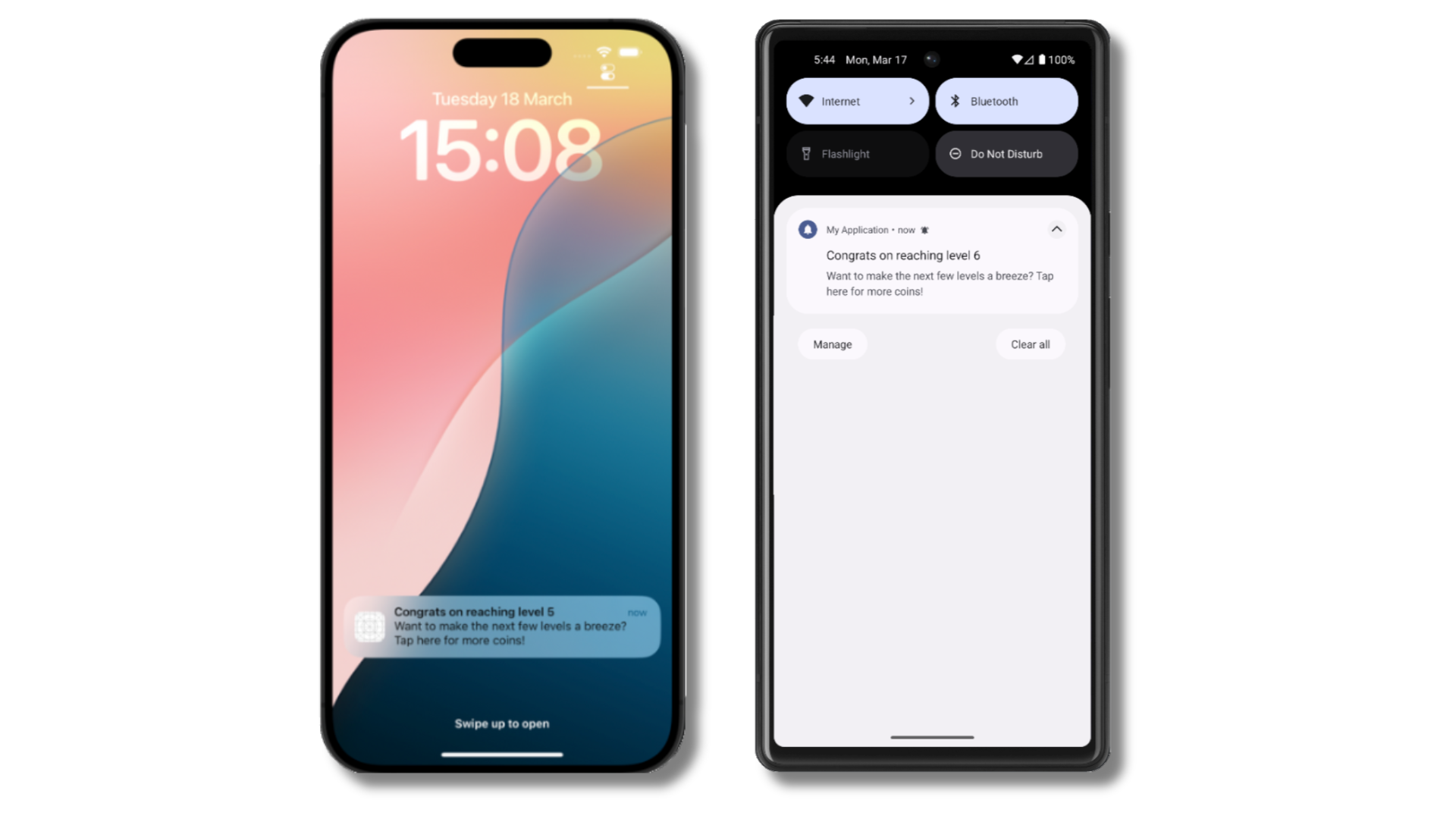
The push notification is received on an iOS and Android device with the personalized content
Add email and/or SMS subscriptions
Earlier we saw how our SDK creates mobile subscriptions to send push and in-app messages. You can also reach users through emails and SMS channels by creating the corresponding subscriptions.- Use the
addEmailmethod to create email subscriptions. - Use the
addSmsmethod to create SMS subscriptions.
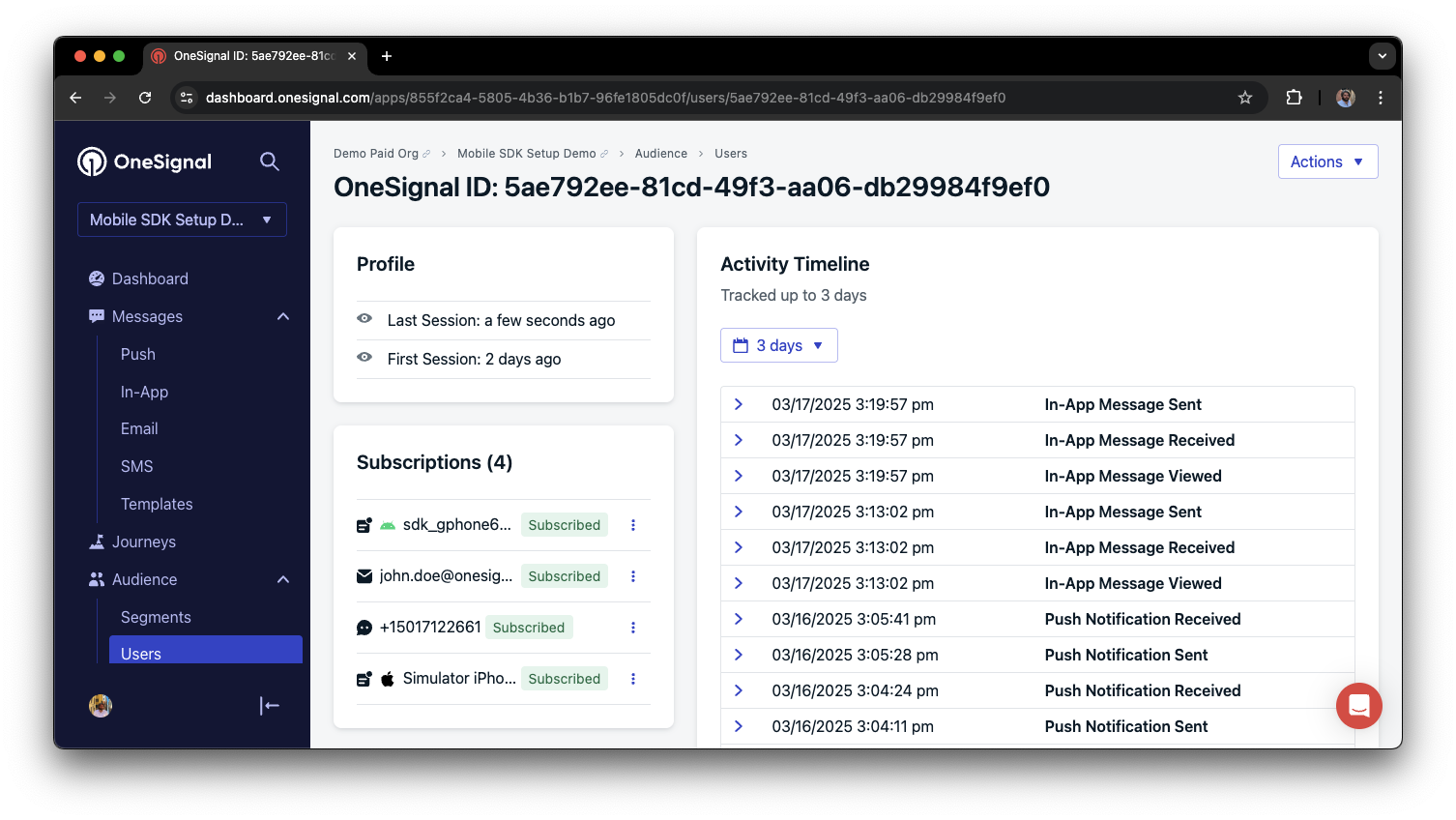
A user profile with push, email, and SMS subscriptions unified by External ID
- Obtain explicit consent before adding email or SMS subscriptions.
- Explain the benefits of each communication channel to users.
- Provide channel preferences so users can select which channels they prefer.
Privacy & user consent
To control when OneSignal collects user data, use the SDK’s consent gating methods:setConsentRequired(true): Prevents data collection until consent is given.setConsentGiven(true): Enables data collection once consent is granted.
Prompt for push permissions
Instead of callingrequestPermission() immediately on app open, take a more strategic approach. Use an in-app message to explain the value of push notifications before requesting permission.
For best practices and implementation details, see our Prompt for push permissions guide.
Listen to push, user, and in-app events
Use SDK listeners to react to user actions and state changes. The SDK provides several event listeners for you to hook into. See our SDK reference guide for more details.Push notification events
addClickListener(): Detect when a notification is tapped. Helpful for Deep Linking.addForegroundLifecycleListener(): Control how notifications behave in foreground.
User state changes
addObserver()for user state: Detect when the External ID is set.addPermissionObserver(): Track the user’s specific interaction with the native push permission prompt.addObserver()for push subscription: Track when the push subscription status changes.
In-app message events
addClickListener(): Handle in-app click actions. Ideal for deep linking or tracking events.addLifecycleListener(): Track full lifecycle of in-app messages (shown, clicked, dismissed, etc.).
Advanced setup & capabilities
Explore more capabilities to enhance your integration:- 🔁 Migrating to OneSignal from another service
- 🌍 Location tracking
- 🔗 Deep Linking
- 🔌 Integrations
- 🧩 Mobile Service Extensions
- 🛎️ Action buttons
- 🌐 Multi-language messaging
- 🛡️ Identity Verification
- 📊 Custom Outcomes
- 📲 Live Activities
Mobile SDK setup & reference
Make sure you’ve enabled all key features by reviewing the Mobile push setup guide. For full details on available methods and configuration options, visit the Mobile SDK reference.[email protected]으로 이메일을 보내주세요.다음을 포함해 주세요:- 발생한 문제의 세부 정보 및 재현 단계(가능한 경우)
- OneSignal 앱 ID
- External ID 또는 Subscription ID(해당하는 경우)
- OneSignal 대시보드에서 테스트한 메시지의 URL(해당하는 경우)
- 관련 로그 또는 오류 메시지